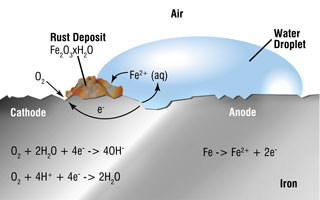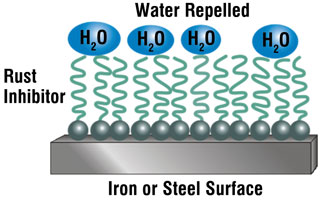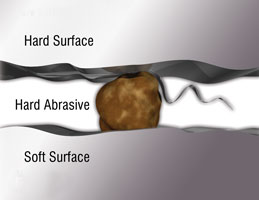Inhibiting Rust and Corrosion to Prevent Machine Failures
Corrosion costs companies billions of dollars each year. Much of this loss is due to the corrosion of iron and steel. When exposed to moisture and oxygen, iron and steel will react, forming an oxide. This oxide does not firmly adhere to the surface of the metal and will flake off, causing pitting. Extensive pitting eventually results in weakness and disintegration of the metal, leading to failure.
Obviously, because of the involvement with water, rust occurs much more rapidly in moist conditions. However, there are a few other factors that determine the rate of corrosion. One example is the presence of salt. Dissolved salt increases the conductivity of the aqueous solution formed at the surface of the metal and enhances the rate of electro-chemical erosion. Another example is heat. The higher the temperature is, the higher the corrosion rate will be.

Rust Formation
The formation of rust is a very complex process that begins with the oxidation of iron to ferrous (iron “+2”) ions.
For the next sequence of reactions, both water and oxygen are required. The iron (+2) ions are further oxidized to form ferric (iron “+3”) ions.
The electrons provided from both oxidation steps are used to reduce oxygen.


The ferric ions then combine with oxygen to form ferric oxide, which is then hydrated with varying amounts of water.
In layman’s terms: Iron + Oxygen + Water = Hydrated Iron Oxide (Rust)
Other types of corrosion can occur in machine components, namely corrosion from organic acids. These organic acids can form in multiple ways and can even be a byproduct of the oil aging (oxidation). They are weak compared to common inorganic acids but still hydrolyze well enough to damage most metals.
One example is acetic acid. It is mildly corrosive to metals, including iron, magnesium and zinc, forming hydrogen gas and salts called acetates:
In layman’s terms: Iron + Organic Acid = Iron Acetate + Hydrogen
Corrosion Inhibitor Options
Corrosion inhibitors are available in many forms with various functions to protect equipment. Liquid-phase corrosion inhibitors ensure surfaces covered by the liquid will be protected by the strong additives in the fluid. Vapor-phase protection may be included with the liquid-phase protection or used in dry reservoirs. It works by filling the headspace with a vapor that prevents corrosion. Surface coatings protect systems by adhering to the surface. Generally, surface coatings repel water from the surface and include an additive to reduce corrosion at the surface.
Rust and Corrosion Inhibitors
The best way to stop rust and corrosion is not to allow the metal to come in contact with water, oxygen or acid. In essence, this is exactly what rust and corrosion inhibitors do. These additives are typically compounds that have a high polar attraction toward metal surfaces. They chemically bond to the metal surface, forming a protective film over the underlying metal. This film acts as a barrier that does not physically allow the metal to come in contact with anything that could promote corrosion. Some popular compounds being used are amine succinates and alkaline earth sulfanates.
If rust formation cannot be prevented, the rust particles can flake off and contribute to abrasive wear. The iron oxide is much harder than the steel surfaces it comes in contact with, so massive amounts of three-body abrasion occur.
 The rust-protective properties of an oil can be hard to evaluate and are somewhat subjective. For best results, the lab must polish or sandblast a test specimen and then immediately coat it with the oil to be tested. After coating, the lab can then begin subjecting the specimen to conditions that accompany rust formation. ASTM D665, although denoted as “Rust Preventative Characteristics of Steam Turbine Oil,” can be used for any formulation of oil. In this test, a steel specimen is immersed in a mixture of distilled or synthetic sea water. Over a 24-hour period, the mixture is agitated and checked for the formation of the onset of rust.
The rust-protective properties of an oil can be hard to evaluate and are somewhat subjective. For best results, the lab must polish or sandblast a test specimen and then immediately coat it with the oil to be tested. After coating, the lab can then begin subjecting the specimen to conditions that accompany rust formation. ASTM D665, although denoted as “Rust Preventative Characteristics of Steam Turbine Oil,” can be used for any formulation of oil. In this test, a steel specimen is immersed in a mixture of distilled or synthetic sea water. Over a 24-hour period, the mixture is agitated and checked for the formation of the onset of rust.
Rust and corrosion are detrimental to your reliability program. Remember to always fight it at its root causes. Eliminate the root causes of a failure and you will reduce the likelihood of that failure’s occurrence.
